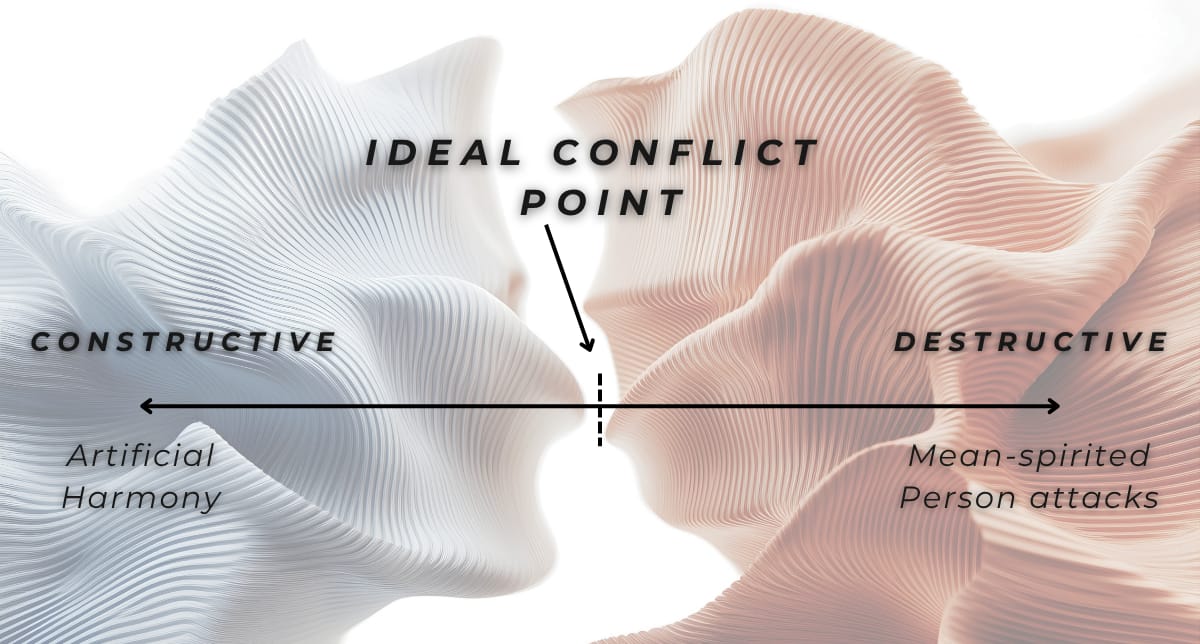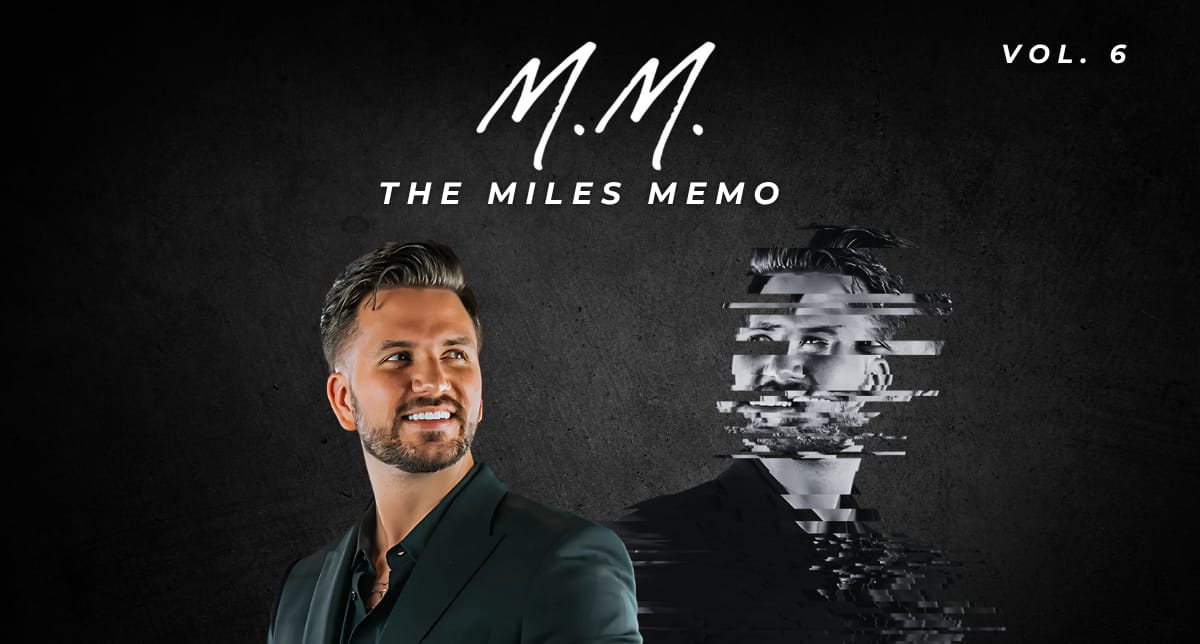I went from being an SDR making less than 40k/yr to being President / CEO (and partner) of the most prominent consulting company in my industry.
I did that in about 48 months.
And what I’m about to share with you is one of the MOST important skillsets that I learned along the way.
I can confidently tell you I wouldn’t have been able to achieve what I did if I hadn’t learned and implemented this skill.
It’s the art and science of having hard conversations.
If you desire to be a better leader, increase your influence, acquire more customers, build a better team, have better friendships and relationships, or what have you…
You can not and will not accomplish any of these things, without having hard conversations.
And doing it well.
The better you get at this, watch your life and business improve.
Remember this…
The gap between where you are now and where you want to be in life and business is the amount of hard conversations you're willing to have.
Jesus made a statement at the beginning of one of the most influential speeches of all time.
“Blessed are the peacemakers, for they will be called children of God.”
Notice he said peaceMAKERS, not peace keepers.
Why is this relevant?
Too many leaders think their job is to keep the peace. You know, keep everyone happy and smiling.
No, wrong.
Your job is to do what’s BEST for them. Call them forward and help them grow.
And that, my friend, requires conflict. The right kind of conflict.
Let me explain what I mean by that, because most people hear "conflict" and immediately think of destructive, toxic, relationship ending blow ups.
That's not what I'm talking about.
There are actually two extremes most teams fall into, and both are equally destructive.
Patrick Lencioni talks about this concept and does a fantastic job of visualizing it.

On one end, you have artificial harmony.
On the other, you have mean spirited attacks, the bad kind.
Artificial harmony looks like…
Boring meetings where nobody really says what they think
Back channel conversations where real opinions get aired privately
Decisions that drag on forever because we're too busy protecting feelings to actually solve problems
I’m sure you can imagine or have experienced these kinds of scenarios.
When people are disengaged, momentum stalls, and everyone's being polite while quietly resenting each other.
On the other hand, you have the other extreme…
Personal attacks, emotional outbursts, and fighting to win rather than fighting to resolve.
Most people pendulum swing between the two and completely miss the ideal conflict point.
The goal isn't to avoid conflict at all.
Cultivate the right KIND of conflict.
Healthy conflict is what happens when you care enough about someone to tell them the truth, even when it's uncomfortable.
It's choosing to be a peacemaker instead of a peacekeeper.
Peacekeepers avoid tension at all costs.
Peacemakers walk directly into tension because they know that's where real resolution lives.
Here's the framework I use when I need to have a hard conversation.
I've taught this to many leaders and it works because it's built on a few non negotiable cornerstones.
These principles are absolutely essential BEFORE even going into the conversation. Trust me, a little bit of preparation before these conversations will save you so much time, frustration, and relational equity.
1- Assume the best about the other person.
Most conflict happens because we've created a story in our head about someone's intentions. We assume malice when it's usually just miscommunication or misalignment.
If you can’t find the fortitude to assume the best, then don’t make any assumptions at all.
Stay neutral.
If it’s bad enough and you find yourself too emotionally charged, then purge the head trash.
2- Purge the head trash and get clear.
I do this by going on a walk and journaling.
There’s something called the M3 method.
Music
Movement
Mindfulness
Either one or all of those three really help to process and get clear.
That’s why I go on a walk, while listening to music, and write in my notes app.
Ask yourself:
What’s the story I’m telling myself about this situation?
What are the objective facts of the situation, without my emotions or assumptions attached?
What would the most secure, healthy version of myself think or do in this situation?
If I were advising a mentee in this situation, how would I lead them?
What are the core values I need to uphold here?
This step alone will save you from 80% of unnecessary conflict.
3- Don't seek to win the conversation, seek a meaningful outcome.
The moment you're trying to prove you're right, you've already lost sight of what matters.
If we’re all honest, at the end of the day what matters is resolution.
And resolution requires collaboration.
Let go of the need to be validated, to be right and instead focus your effort toward the most meaningful outcome.
4- Use precise language.
This one can be hard for a lot of people, including myself.
That’s why it’s important to purge the emotional charges, the head trash and get clear before going into the conversation.
Because the language we use can derail the whole process.
Seriously, 80% of the challenge in these conversations is simply avoiding things getting derailed.
And the language we use is most of the time, the enemy hidden in plain sight.
"You're always late" → combative and inaccurate.
"You've been late to the last four leadership meetings" → factual and addressable.
Use "I" statements.
"I've noticed X" instead of "You always do X."
State facts and avoid exaggeration and combative language.
With that said, I’ve distilled down a seven step framework for these hard conversations.
I use it myself, it works.

Step 1: Set the frame.
For this, I recommend just getting to the point. Dancing around the issue while you both know there’s an elephant in the room is just painful and makes the process worse.
It’s unnecessary.
Say why you're there right away.
"I wanted to talk because I've noticed some things that I think are getting in the way of you hitting your goals, and I want to make sure we address them."
Step 2: Address assumptions.
Before they spiral into worst case scenarios in their head, which happens to all of us, clarify what this conversation is and isn't.
"Look first things first… you're not getting fired. I just want to make sure we're aligned."
Step 3: State the desired outcome.
"The goal here is I want you to win. You told me your long term goal is X. In order for that to happen, we need to address Y."
This shifts the frame from adversarial to collaborative.
Step 4: Attack the behavior, not the person.
Reinforce the values. Make it about the standard, not your personal preference.
Most importantly, make it about what’s best for THEM.
"Can you see how consistently being negative in meetings is pushing people away and making it harder for the team to get and stay in sync?"
Not "You're negative and it annoys everyone."
One is about their behavior and the standard we set as a company.
The other is about their identity and subjective opinion, which are not synonymous with principles.
Step 5: Show your support.
"I believe you're more than capable of making this shift. What do you need from me to make that happen?"
This is critical…
You're not just pointing out the problem, but you’re collaborating and offering to be part of the solution.
This also reflects that you believe in them.
Step 6: Get agreements.
"Can we agree 100% that moving forward, X will happen?"
Avoid "I hope you'll try to..."
Or "It would be great if..."
No, get a clear commitment.
“Manage agreements, not expectations” is a principle I live by and has served me well.
Here's the thing about hard conversations, ironically, is they're only hard if you wait too long to have them.
These issues are like mildew, they only grow as long as they’re covered up.
And the longer you wait, the more resentment builds.
The more the story in your head becomes "truth”, the more the other person is blindsided when you finally bring it up.
My dad gave me advice years ago that changed how I approach conflict: Don't let it get to the bitter end.
Say something earlier.
That team member who's been late to meetings?
Address it the first time, not the sixth.
The gap between identifying a problem and addressing it is where resentment grows.
And resentment is the silent killer of teams, relationships, and influence.
I've seen this play out hundreds of times…
The leaders who have the most influence aren't the ones who avoid conflict, it’s the opposite.
They're the ones who lean into it early, with clarity and care.
People don't resent leaders who hold them accountable, especially A players, the ones you want on your team.
They resent leaders who let them fail in silence and then act surprised when things fall apart.
There's a passage in Proverbs that says:
"Faithful are the wounds of a friend, but deceitful are the kisses of an enemy."
In other words…
People who care about you will tell you hard truths. People who don't care will let you stay comfortable in your dysfunction.
If you're in leadership, if you're responsible for anyone, you have a moral obligation to have hard conversations.
Not because it’s fun, but because avoiding them is cowardice disguised as kindness.
Think about the conversation you avoided at some point.
Or maybe you have one now.
What's it costing you? What's it costing them?
And more importantly, what kind of leader are you becoming by choosing silence over truth?
Because here's what I know for sure after years of having more hard conversations than I care to count....
The conversations you avoid today become the crises you manage tomorrow.
Because you not only continue to get what you tolerate… what you tolerate, you promote.
It compounds.
The leaders who master the art of hard conversations build cultures where people actually want to follow them…
And where people consistently grow because “blindspots” are brought to their attention.
Because they trust you enough to tell them the truth.
Till next time,
- The Miles Memo

-Mitchell Miles - CEO

